Sandwiched between South Africa and Tanzania, Mozambique is often a forgotten Southern African destination as most people choose to visit its more developed and stable neighbors. However, Mozambique has one of the longest coastlines in the world, ripe with the nicest beaches I’ve ever seen, delicious seafood, and culture unlike anywhere else I’ve seen. I spent a month traveling this country and wish I had stayed longer!
History of Mozambique
The first inhabitants of what is now Mozambique were the San hunters and gatherers, ancestors of the Khoisani peoples. Between the 1st and 5th centuries AD, waves of Bantu-speaking peoples migrated from the north through the Zambezi River valley and then gradually into the plateau and coastal areas. The Bantu were farmers and ironworkers.
When Vasco da Gama, exploring for Portugal, reached the coast of Mozambique in 1498, Arab trading settlements had existed along the coast and outlying islands for several centuries, and political control of the coast was in the hands of a string of local sultans. Muslims had actually lived in the region for quite some time and most of the local people had embraced Islam.
Mozambique was a colony of Portugal until 1975, when an 11-year war of independence ended with the establishment of an independent, Marxist government. But a 17-year civil war started soon after independence, with an internal military uprising that some foreign governments supported.
The civil war affected Mozambicans severely, especially in rural areas. Hundreds of thousands of people were killed. Over a million people fled the country, especially to Malawi, and more than a million others were displaced within Mozambique.
Many rural people migrated to the cities, especially along the coast where the government maintained control. The country went into severe economic depression. Agriculture was disrupted, so the country could not feed itself. By the late 1980s, Mozambique had one of the lowest per-capita caloric intakes in the world.
Nowadays, Mozambique has come a long ways from its days of civil war. Most recently, there was a brief stint of internal conflict between the incumbent FRELIMO party, and the RENAMO party. Travelers I met that traveled between Beira and Vilanculos (Renamo territory), had to travel via military convoy and one person even told me someone was shot in his van. A peace treaty was signed in 2014 before their most recent elections
Getting to Mozambique
Mozambique can be reached by overlanding from South Africa, Zimbabwe, Malawi, or Tanzania. Most will cross the South African-Mozambique border if visiting the southern areas (Maputo, Tofo, Ponta Do Ouro etc).
From Kruger National Park and South Africa to Mozambique
This is perhaps the most common crossing. Many people visit the Kruger in South Africa and then extend their trip into Mozambique. The most common border crossing used here is the Lembombo Border Control. This can get crazy at times especially during the afternoon hours. I would highly recommend going here in the early morning when they first open. The South African side is efficient and fast, but once you reach the Mozambique side, anything goes but be sure to exercise great patience.
If you’re further north in the Kruger, use the Giriyondo Border Crossing. This crossing is far less busy than Lembombo.
From Swaziland to Mozambique
Swaziland also shares a border with Mozambique and is a popular transfer country for those that want to visit the Hlane National Park. From Swaziland, you’ll want to take the Namaacha Border control. I’d also highly recommend coming here in the mornings as the traffic can really pile up later in the day.
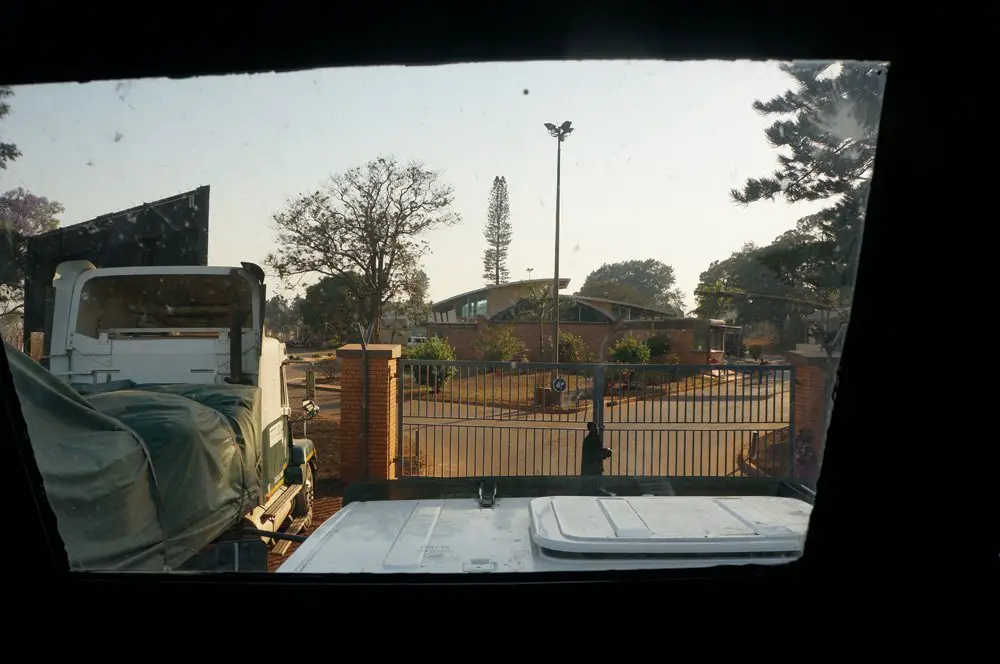
From Malawi
While traveling through the north, I met many travelers that overlanded via the Malawi/Mozambique border. This seemed a popular itinerary to spend a few nights in Lake Malawi and cross into Mozambique via the Mandimba border post, and travel by land through Cuamba to Ilha de Mozambique.
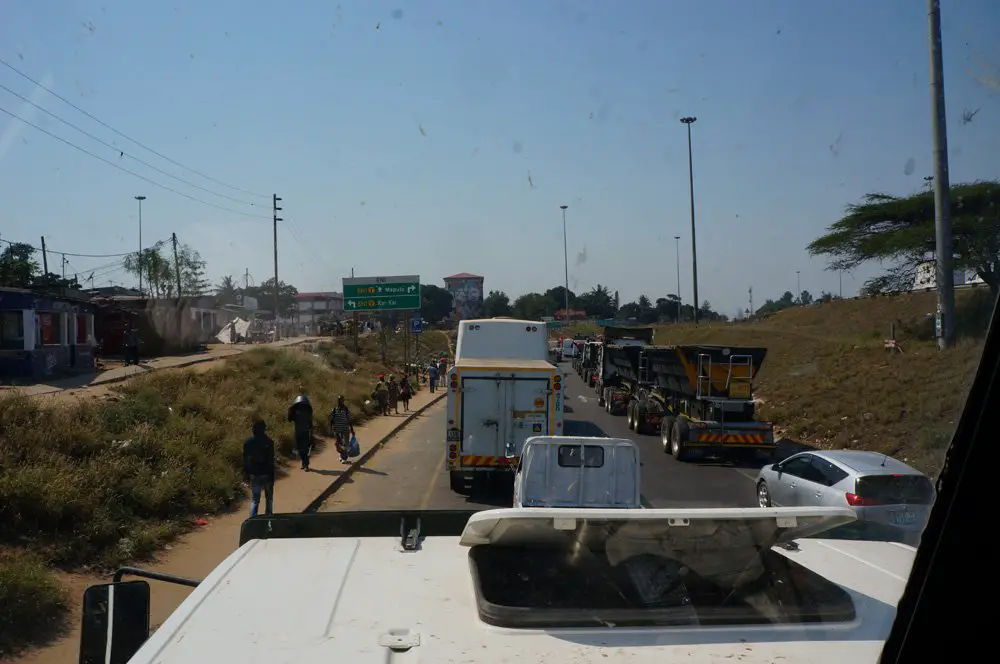
Air Travel in Mozambique
By air, South African flies direct from Johannesburg to most of Mozambique (Maputo, Inhambane/Tofo, Vilanculos, Pemba). LAM airlines, Mozambique’s national airline also has flights, albeit expensive ones, throughout the country. Flying around Mozambique is not cheap, and one of the biggest complaints from talking to some expats living in Mozambique.
Flying around Africa in general is not cheap and Mozambique is no different. A flight from Maputo (the capital) to Pemba can easily be over $500 round trip. A flight from Johannesburg to Pemba via South African airways is over $800!

Getting the Mozambique Visa
This one is tricky. Prior to August 2014, visas could be bought upon arrival like all the surrounding countries. After Aug 2014, visas MUST be obtained before arrival. Only a few surrounding African countries do not need visas.
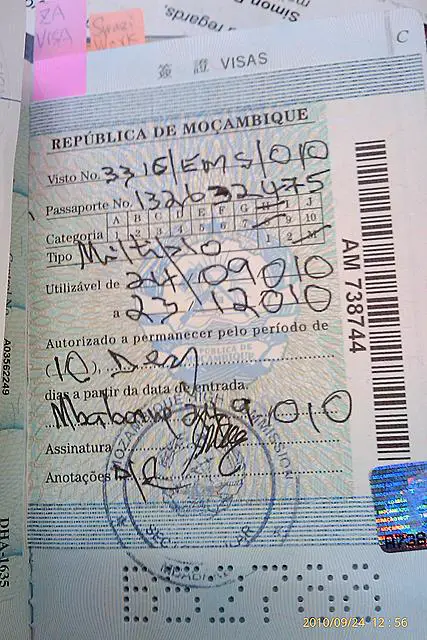
While it is a simple same day task if living in Johannesburg, this will likely be a painful process. Fear not however, after crossing the Swaziland/Mozambique border, there may be hope that visas can still be purchased at the border. While I already had my visa sorted out before hand, there were signs at the counters listing prices for Mozambican visas in dollars, rands, pounds, and euros. I’m not sure if they were just too lazy to update their policy, or if they still sold visas at the border.
Update 2019: As of 2019, Mozambique allows all visitors to obtain visas on arrival. This includes the major airports (Maputo, Vilanculos, Pemba, Inhambane) as well as the main land borders between South Africa and Swaziland.
Transportation and Getting Around in Mozambique
Mozambique is a large country, and overlanding will take some serious time. Driving is only recommended through the southern region and even then, there are some hectic stories of police corruption. Nothing dangerous per se but let’s just say that bribes are as common as seeing a beautiful beach in this country.
Driving from South Africa
Driving from South Africa into Mozambique is very popular. Car rental agencies in South Africa are familiar with the protocols and you’ll need a letter to carry with you to the border crossing. Most car rental agencies provide this for R500 or so. Mozambique also has requirements for cars entering the country but if you tell your car rental agency in South Africa beforehand, they should have all the necessities (although I’ve never been checked for this), including:
- two warning triangles
- one reflective vest (it’s better to have two to avoid long arguments with police)
- jack
- a belt holding down the battery
- Yellow triangle on blue background stickers on front of car and back of trailer if towing
You will also need to buy third party insurance in Mozambique, even if you have insurance from South Africa, or from a credit card. Doesn’t matter. Don’t buy it from any sketch people, just stick to the official people at the border post.
Chappas
Chappas are how the locals get around. These questionable minivans are all over the country. It’s possible to take a chappa from Maputo all the way to Pemba if one had loads of time and patience. Like public vans in other African countries, chappas will only depart when they’re full. It’s also one of the cheapest ways to get around Mozambique.
For example, a chappa from Nampula to Ilha De Mozambique (200km) is about 300 mets I took a few and am pleasantly surprised at how efficient and quick these guys are. Aside from a few very curious stares, I had a great time riding these. The one or two people that could speak English made for great conversation!

Hitch-hiking through Mozambique
You may read this and think I’m a madman hitch-hiking by myself through a developing nation like Mozambique. I’m not saying it’s the safest way to go about things, especially for a lone female traveler, but the few times I did hitch-hike around this country, I had a great experience, and got to where I needed to go much quicker. Hitch-hiking is common among Mozambique backpackers, and likely more convenient than waiting around for a chappa to fill up.
Semi-trucks will frequently pick up hitch-hikers, and the unspoken payment is 1-2 mts per km. Truck drivers are already driving from point a to point b so if your destination is point b, then they’re just making an extra buck by picking you up. Win-win for all parties!
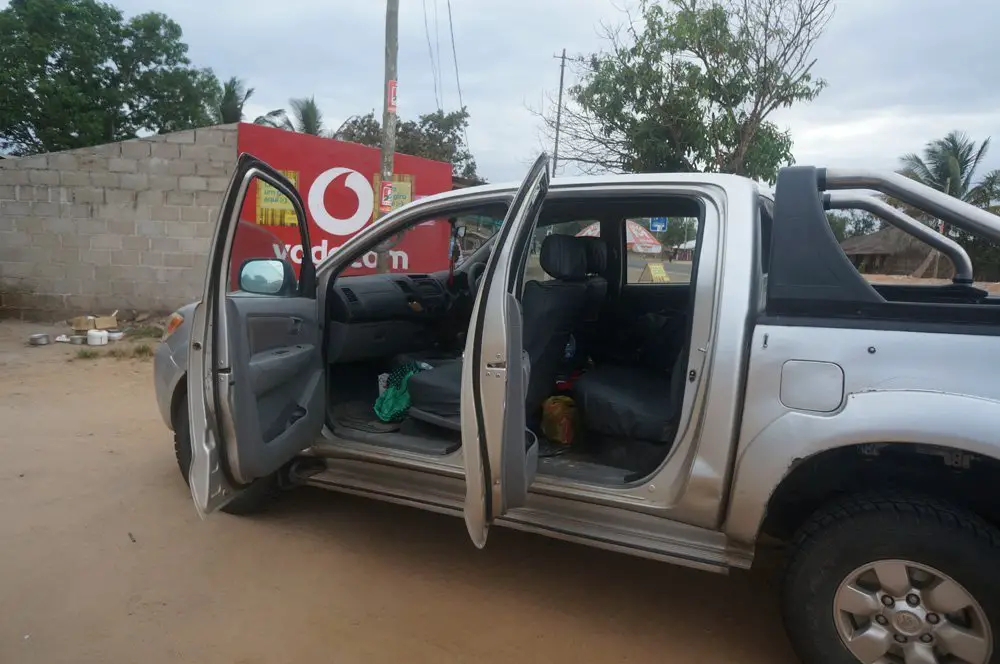
Tourism in Mozambique
Mozambique can be divided into three parts:

South Mozambique
Can also be referred to as South Africa’s Mozambique, the areas from Ponta D’ouro at the very south to Vilanculos (Bazaruto Archipelago) is prime South African getaway spots. Beaches here are more like the beaches along the Garden route and Durban. Maputo, the nation’s capital is in the very south, bordering South Africa.
Middle
There isn’t much to see in the middle besides the Gorongosa National Park (didn’t visit this one). This national park from what I’ve heard, used to be one of the most beautiful nature reserves in Africa, teeming with endless wildlife. During Mozambique’s civil war however, nothing in the country was spared and most of the animals in this park were killed off. Beira is a large port town that was once a popular destination for wealthy Zimbabweans (before that country went to shit). Anyone looking to overland through the entire country will likely pass through this town.
North Mozambique
Ilha De Mozambique, Pemba, and the Quirimbas Archipelago occupy the north. This part of the country was one of the least developed places I saw in Africa (with the exception of Pemba which is quickly becoming a big city due to natural gas discovery). The Quirimbas Archipelago has perhaps some of the most stunning and certainly the nicest beaches I’ve ever seen. It’s completely untouched and those that invest the time to get there will be substantially rewarded.
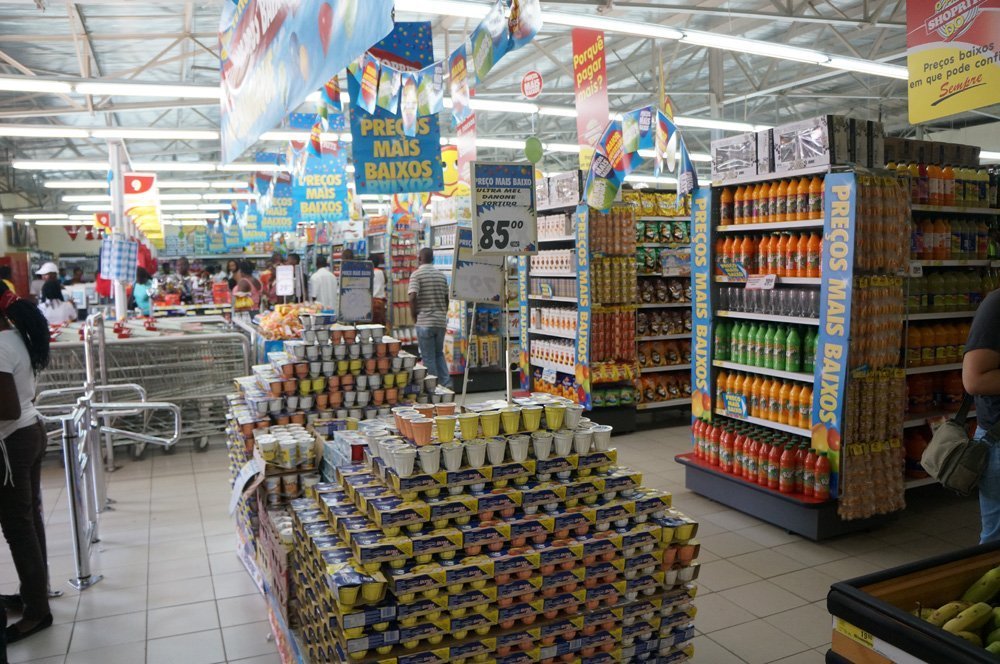
Comparing the Regions of Mozambique
Mozambique is a huge country. The coastline spans 2,500km and there are over 40 languages spoken in the country.
South Mozambique
From my time spent in Moz, there is a stark contrast between the north and south. Tourism is far more developed in the south with places like Ponta do Ouro and Tofo being huge South Africa getaways. There are hundreds of hotels, backpackers, lodges in Tofo and it has that mass tourism beach getaway feel. While I never visited Ponta Do Ouro in the very south of Mozambique, many of my South African friends either have homes here or visit frequently.
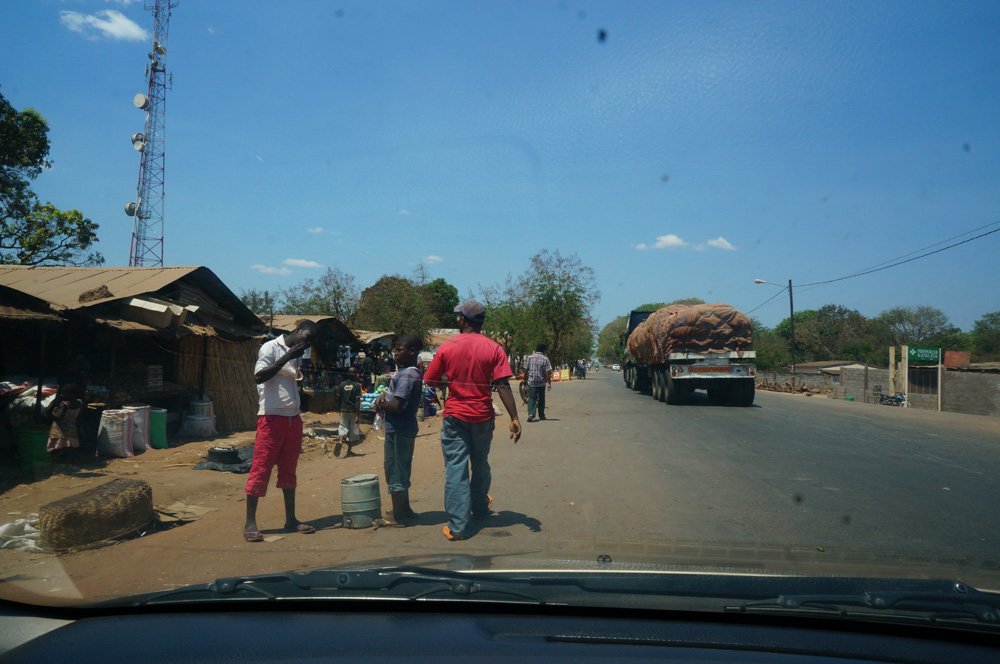
Vilanculos and the Bazaruto is still prime South African tourism territory with a few backpacker lodges in Vilanculos. The Bazaruto is a premium luxury location with some incredibly expensive private islands with private hotels. Places like Azura, Indigo Bay Lodge, and plenty others can easily run you over $1000 a night.
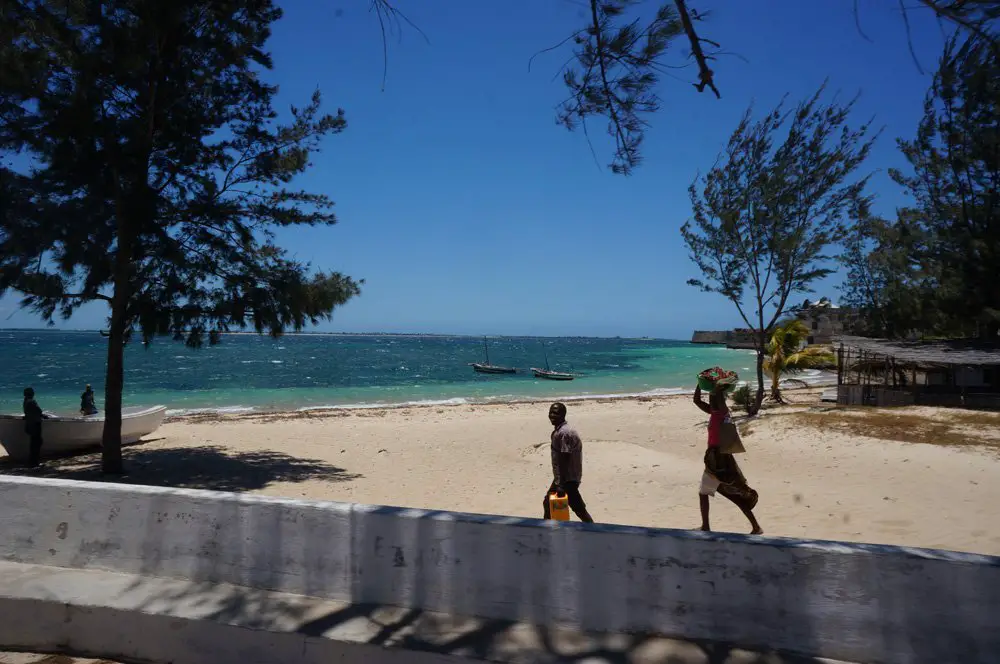
Northern Mozambique
Nevertheless, visiting Ilha De Mozambique, the former colonial capital of Mozambique is a magical and hauntingly beautiful place. The beaches of the Quirimbas are the nicest beaches I’ve ever seen, besting the Bazaruto in my opinion. The Quirimbas are also home to ultra luxury lodges like the Vamizi, Quilalea, and Medjumbe which will easily run over $1000 a night. Fortunately for the wandering traveler, camping is allowed on these islands making a dhow safari possible!

The north of Mozambique might as well be another country compared to the South. The landscape and languages are different to the South and it’s immediately visible how much less developed the North is. Nevertheless, this part is a special place to visit, easily one of my favorite places in all of Africa. Tourism is sparse in these parts but sadly, I feel like it will become much more commercialized in the next five years after huge natural gas reserves were discovered in Pemba.
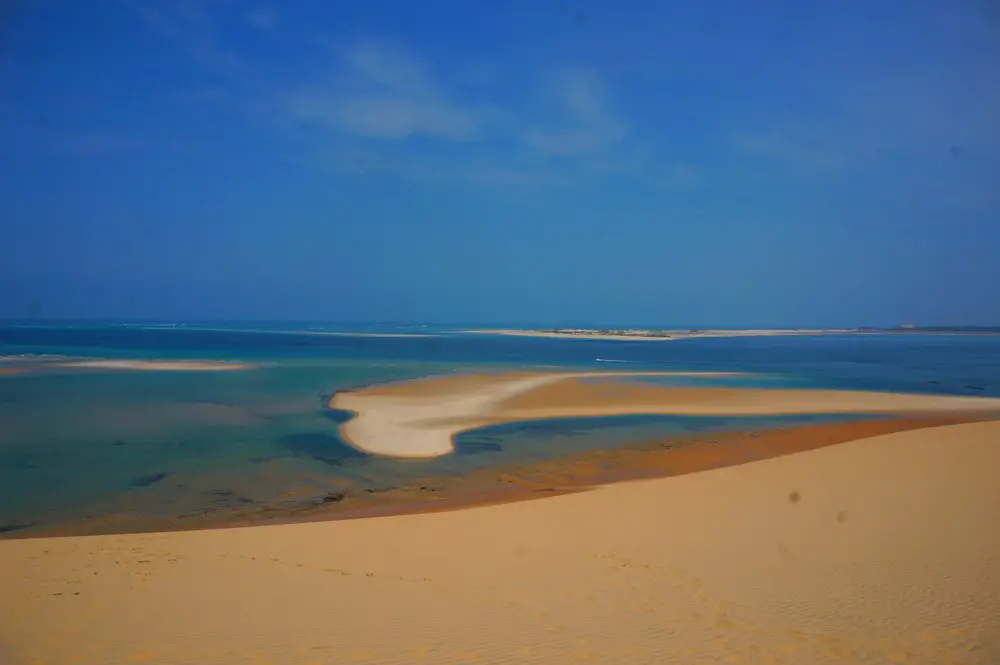
Overall, Mozambique is a different type of getaway to its neighbors. It is less developed, less infrastructure and English is rarely spoken outside of the touristy areas.
Language
As Mozambique was a Portuguese colony, the official language is Portuguese. However, like every other African nation, only a small percentage speak the former colonial language, usually concentrated around the urban areas and the more educated. Many local languages are spoken throughout the country. English is spoken primarily in tourist areas and is more prevalent in the south due to the South African tourists.
Knowing some Portuguese will be extremely helpful here. I made sure to download the offline Portuguese package for my Google Translate app and as of 2015, Google Translate also allows you to speak into the phone translating it in real time. Huge life saver for Mozambique.
Money in Mozambique
Mozambique is a cheap country to travel around but is getting more expensive, especially in the north. With the discovery of gas in Pemba, prices in the north have skyrocketed, and this will inevitably trickle down through the rest of the country. Nevertheless, prices will still feel cheap, especially for things like beer and seafood.

The official currency in Mozambique is the Mozambican Metical (also called Mets, Meticais, Meticash). When I visited in Oct 2014, it was 30 mts to $1, and is at 60 mts to $1 in 2018. South African rand is readily accepted in the south, primarily in the popular South African spots like Tofo and Ponta Do Ouro. In fact, I know in Ponta, rands are preferred to Meticals.
US Dollars are accepted at most high end tourist hotels and easily exchanged at banks, although the best exchange rates are still via ATMs. ATMs are widely available throughout the urban centers of Mozambique.
Credit cards are accepted sparsely, primarily in Maputo, and high end tourist spots. If a vendor accepts credit card, they will likely charge a fee of a few percent. If you’re a backpacker, I’d visit Mozambique with a no credit card mindset, cash is king here!
Food in Mozambique
Having traveled through much of Africa, most culinary options are so bland (with the exception of South Africa of course). Mozambique, thankfully, is blessed with a coast full of delicious seafood. The Portuguese also left behind many of its culinary traditions, especially the use of peri-peri sauce, a spicy delicious sauce that goes good with everything. Pair this with their deliciously cheap seafood, and life is good.

Mozambique is famous for its giant tiger prawns that can grow up to 1ft long! Along with lobsters, calamari, octopus, and many fish, the seafood options are endless here. While in Tofo, I would regularly visit the beach where guys were ready to sell me lobsters or prawns and bargain the shit out of them. Eventually, I’d get the price of prawns down to 200mts ($6) for a kilo of giant prawns which is just ridiculous. I would then tell the chef at the hotel’s restaurant to grill it with some peri peri sauce, give him a buck or two, and be in food coma heaven.
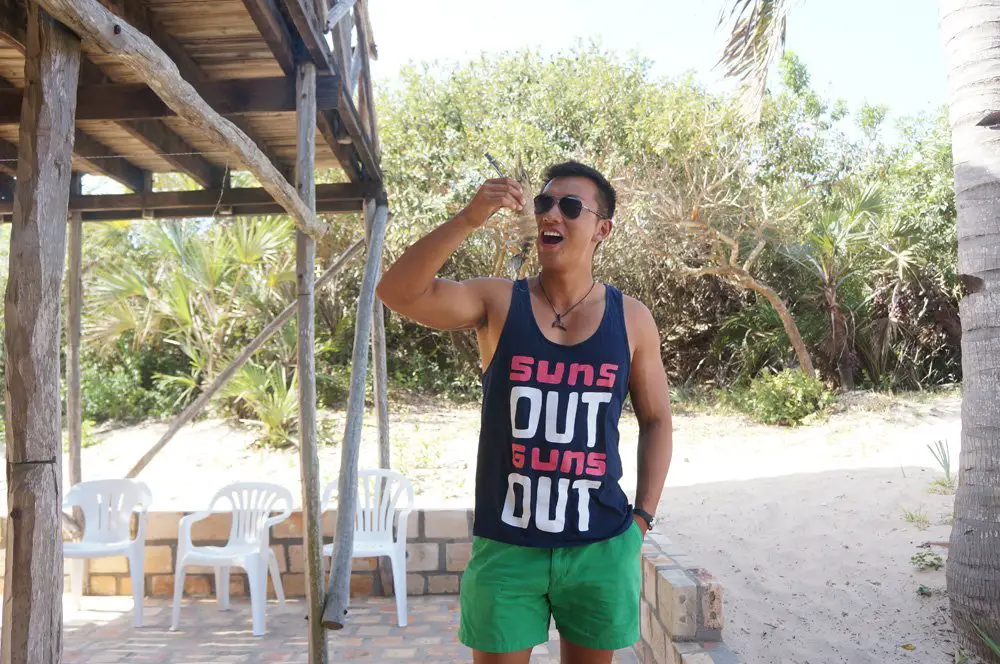


When to Visit
Mozambique enjoys a beautiful coastline of 2,500 km and is beautiful year round. Nevertheless, he heavy rains come between December to April and travel during this period may be difficult. May to October are considered the best months to visit. Temperatures in the north are generally warmer than the south. Maputo in the deep south can reach freezing temperatures in the winter months!
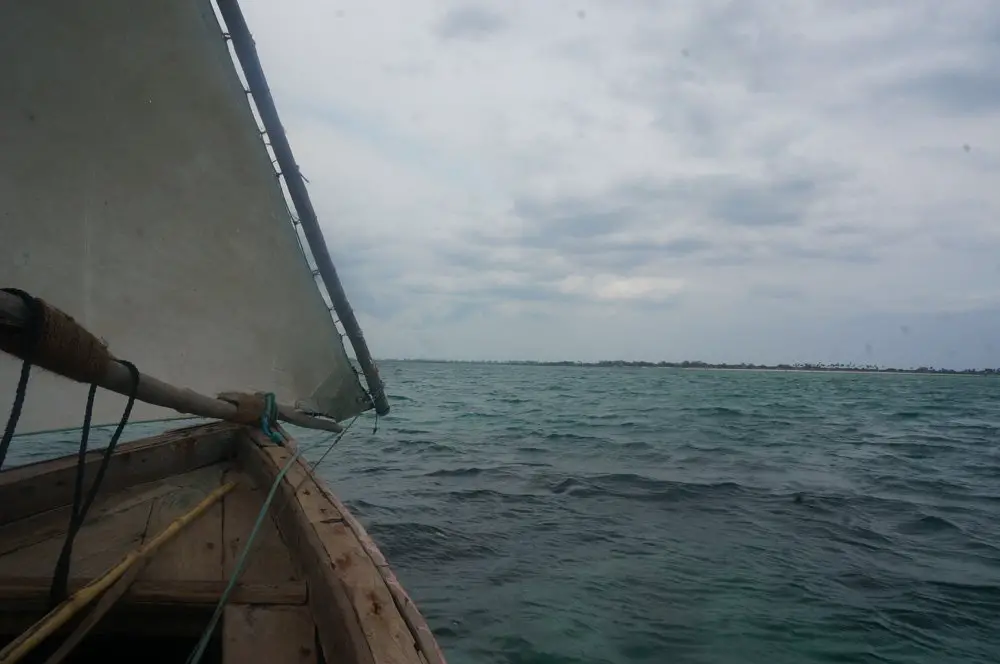
I went in October and this was approaching the rainy season but temperatures and climate were starting to become volatile. It was wildly inconsistent in Tofo, with winds constantly being the cause of cancellation for our dive trips. Vilanculos and the Bazaruto were mostly sunny but the mornings would always see clouds. Northern Mozambique seems to follow a more sub-tropical/tropical climate and it was sunny during my entire visit.
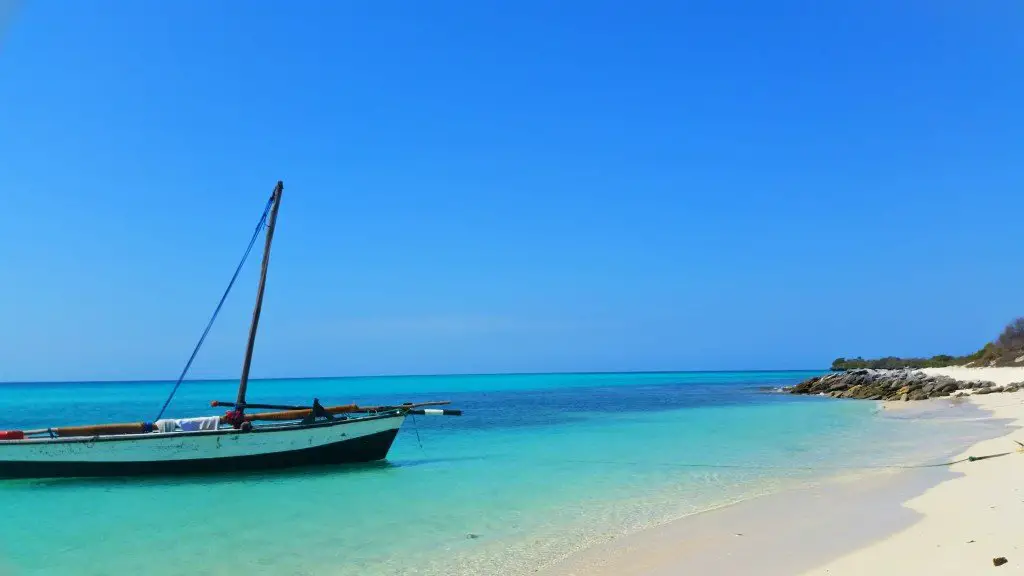
My Mozambique Travel Itinerary
And finally, my four week itinerary for Mozambique. I did the southern part with a Nomad overland tour, stopping in Tofo and the Bazaruto. Initially, I was planning on overlanding from Vilanculos to Nampula in the north (On the map it would be from point C to point G) but after talking to other travelers, this ride would have been long and extremely boring so I winged it and bought a last minute flight from Maputo to Nampula, before winging most of my northern Mozambique circuit.
Read my detailed Mozambique itinerary that follows the route below!
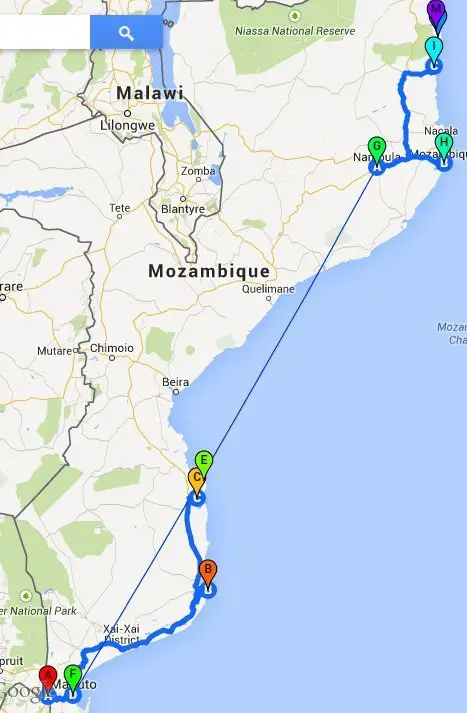





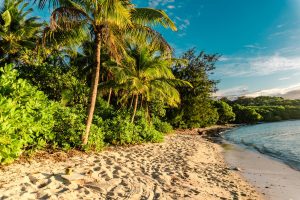


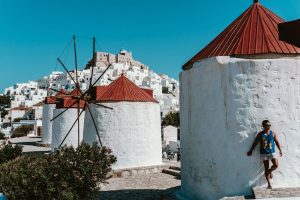


Hi Johnny, Great blog. I have just made an interview with a bloke who walked 800 kms across Mozambique following the Zambezi river. Pretty crazy huh? https://wanderowl.com/trekking-zambezi-through-mozambique-interview-with-alasdair-campbell/
Hi Johnny,
you didnt tell anything about the beaches directly on Ibo island? Are they fine to swim, hang up there and relax? If the other islands have them, I guess Ibo too? Saw also on your pics, there is beach on Ilha Mozambique in town? Do you think, as a solo female, 56, traveller I will be surrounded by local man on the beach? I am used to not so touristic areas as a backpacking woman, but guess f.e. in Ibo, beachboys have not yet began… I speak Portuguese….
Now I will read about Maledives, even I already worked there for half a year ????. Regards from Austria!
Hi Sylvia! The beaches around Ibo are not that great from what I saw. It’s really about getting to the other islands nearby that were breathtaking. As for ilha, I didn’t really get the feel of creepy local dudes harassing tourists like other places I’ve been to. Ilha doesn’t see many tourists so perhaps this is why or I’m just a guy and don’t notice it as much. I think you will be okay though!
Hi Johnny,
thanks 4 the fast replay, nice. Hm, but 1 night out with a Dhow doesnt make sence 4 all the costs and the way…I m mostly out around 8 weeks and want to be longer on nice beach destinations, from one to the next… from Vilanculos there s already a girls blog about harassing beach boys, uff….and I cant go to the expensive islands, but thanks.
Hi Sylvia, you can stay out on Matemo for much longer if you want. I only stayed for 1 night because I didn’t have enough time, otherwise I would have loved to stay for longer. Sadly, affordable acommodations on the nicest of islands are not available.
Hi, thank you very much for your blog about Mozambique! I want to visit north of Mozambique at summer this year and also spend few days just relaxing and snorkeling. Do you think at Quirimbas is nice snorkeling (apart from ultra-luxury private islands) or this area is better for diving? Unfortunatelly I don’t dive. Thanks a lot.
Hi honza, I think you will find great snorkeling in the quirimbas as well as diving. However, I don’t recall any places on Ibo Island where you could just go out and snorkel from shore. You may need to go on a snorkeling trip to nearby reefs. Enjoy your trip there!!
Hi Johnny,
thank you so much for your article. I wanted to do my Divemaster in Tofo for so long because of all the Megafauna. But wasnt sure because of usual cliches we Europeans have about Africa. Luckily, in the end I decided to go nevertherless, and ended up staying 6 months in Tofo! I worked as a DM after my Training was finished and couldnt have been more in love with the place. I reckon that Mozambique will get more touristier in the next few years with so many beautiful beaches and wildlife. x
Thanks Anja! Glad you enjoyed the read. Where did you do your DMT? I have been diving in Tofo and think I went too late in the season for any of the good things (Mid Oct). How was the diving while you were there??
I did it with Peri Peri Divers in Tofo. I dived 5 months Feb – June and saw it all: Whale sharks, giant and reef mantas, dolphins and humpback whales. There is no real colourful reef but the megafauna was sincerly breathtaking!
That’s amazing! I need to go back during those months it seems. Diving with a humpback would be the ultimate experience! Have yet to see a manta birostris too. I think the diving further north in the Quirimbas had extremely colorful corals but not much mega fauna.
nice Blog, I will check again your next post. I got a lot of information from your post. your are a good Blogger. I am Waiting to read your next Blog. Thank You.
Hey Johnny,
I’m headed to Moz in January and I’ll be traveling solo. This will be my second trip; the first time I stuck around Maputo, so I want to see more of the country. I’m trying to decide between Vilanculos/Bazaruto Islands and Pemba/Quirimbas Islands. I feel like Vilanculos and the Bazurutos would be easier, but your post and photos of the Quirimbas have me absolutely intrigued. Due to the secluded nature of the place and lack of tourist infrastructure, I’m wondering how safe and costly this trip would be for a solo female. I’ll have 5-7 days to explore. What are your thoughts? Any tips for either?
Hi T. Michelle! I still have dreams about my time in the Quirimbas. It’s still one of the best travel experiences I can recall. It doesn’t look like it’s changed that much either as there is still little to no information when I look at Ibo tripadvisor. I think 5-7 days is likely to see the Quirimbas. It won’t be cheap because you’ll want to catch the private planes from Pemba to Ibo, otherwise taking the local transport to Ibo will shave off 1 day each way.
I was not as big of a fan of vilankulos but that’s perhaps I didn’t spend enough time there.
Also, January is the rainy season so keep that in mind as you may see hectic weather sometimes! Have a great trip though!
Yes, it’s difficult to find info about travel to the Quirimbas. That’s actually how I found your blog and it’s the most informative site out there! A couple more questions for you. Where can I find info about schedule and cost for the private planes to/from Ibo? I know you were lucky and were able to share with folks you’d previously met, but for others do they book once they arrive in Ibo or is there a website or contact to reserve in advance? Also, how far are the closest islands from Ibo? Are the waters very rough? Thanks!
So I rocked up to Ibo with really no plans. I stayed at the Miti Miwiri and met a group of travelers there that also had likeminded plans. In the end, it was great. You can try contacting them in advance but there aren’t many tourists in Ibo so these types of things are not running on any schedule. The waters are not rough and as you’ve seen from pics, everything is absolutely beautiful.
As for flights, I actually booked my flight at the airport (although I can’t recommend that because you never know what might happen). I would recommend contacting whichever guesthouse you decide to stay with and they will know the most up to date info on flights, as there are not many companies that make the flight.
Hey Johnny, loving your blog 🙂 We are thinking of going end of March/beginning April for just over a week, and wonder where you’d recommend divewise? It’s probably once in a lifetime sort of trip and we’ve been recommended Quirimbas but would we be missing out on the bigger stuff? We also wonder about Tanzania (Mafia was also mentioned) or other parts of Mozambique (Tofo (which is supposed to be hit n miss with whale sharks), and Bazruto (mixed reviews))? Also we read about difficult boat launches in some areas, which might not suit one of us.There’s also a possibility for one of us to extend with a safari type trip at the end/beginning. Thanks!
Hi Bridget, that sounds amazing! How long do you guys both have for your trips? For big stuff, Tofo is probably your better bet to see whale sharks and Mantas (although I’m not sure how the diving is during mar/apr). I only had three dives in the Quirimbas, off of Ibo Island but I must say that the soft corals there were some of the best I’ve ever seen. Not to mention that the Quirimbas as a whole is a very special place with likely the nicest beaches you’ll ever see. The only place that does diving that I could find is Ibo Island Lodge so make sure to contact them before hand to make sure they can accommodate you. I heard Bazaruto is only so so.
I did diving off of Zanzibar and that was pretty good as well. I have never been to Mafia but have heard great things. The good thing about Zanzibar area would be how easy it is to do a safari in the Serengeti before/afterwards would be.
Hey Johnny. We have at most 9 days including arrival/departure days for the diving bit. (Safari bit is more flexible and only one of us). So Mozambique I guess is famous for the big stuff like mantas and whale sharks? However, we’re probably not so able to do the tough beach launches so that might be out. It also might be rainy around March, so the vis would be down I suppose.
Alternatively can you recommend other destinations? Perhaps Mozambique isn’t as great at that time of year as we hoped. We’ve dived around alot of Asia and some parts of Indian Ocean so warm water would be better and I’d say marine life is pretty important! Thanks 🙂
Ah yes, I do remember Tofo being quite rough. I went in Oct so Mar might be pretty similar. They were all boat launches and the waves could get quite hectic. I foudn the diving in the Quirimbas to be much better in terms of scenery. There aren’t much big things there but the corals and fish were out of this world. It is on par with SE Asia diving in my opinion (although perhaps not to the same level as Sipadan and Komodo). The visibility was also quite good and waters warm. If you’re set on doing Mozambique, I would recommend a visit to the northern part :). However, make sure that Ibo Lodge is still offering diving (and it’s not cheap unfortunately). Otherwise, stick to the Tanzanian islands as they are much more developed and have more variety with their dive shops.
I love Mozambique but trust me….If you want to travel here I recommend you visit: http://www.gobundu.com/ …these guys are Mozambique EXPERTS! The advantages of a trusted agent that knows Mozambique and how to travel there are priceless!
hi, im in my late 40s, male, single – just want the latest news of how to travel backpacking to maputo and surroundings. Any tips advise? I just wanna be away for a bitfrom jhb, but meet nice new companions with the same objective. Live and enjoy. Say from the 6 july onwards. Any small groups going that way whereby i could join in? I dont have trnsport, so bus, taxi, chappa etc advise for me? Cont numbers of anyone/group with same intention?
Did you ever travel to Mozambique? If so, did you end up going with overland tours or solo??